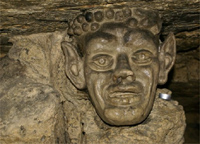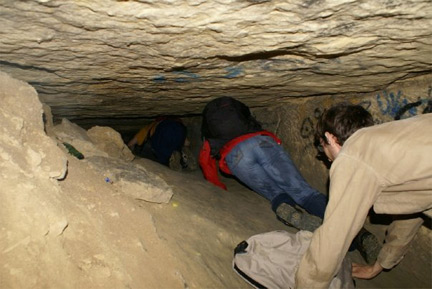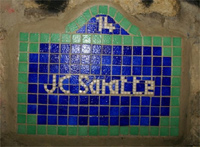The catacombs of Paris and a journey into the unknown - part 2
by Marco Chown Oved
Article published on the 2009-04-30 Latest update 2009-06-17 10:42 TU
According to legend, the French resistance kept an HQ in the catacombs only a few hundred metres from where the occupying Germans had set up theirs. While there was no fighting in the tunnels themselves, apparently there was a bit of cat-and-mouse between the two sides.
And this cat-and-mouse continues today, with the IGC, the cataphiles and the police all walking the same tunnels, avoiding, chasing and hiding from one another.
In a busy Parisian café, Morthicia (her cataphile pseudonym), sips a glass of white wine and reflects on the relationship between the different players in the tunnels.
“The cataphiles believe deeply that the catacombs belong to them, and that no one has got the right to take them away,” she said. Morticia gained a bit of noteriety in cataphile circles as one of the founding members of the “catachicks”, a group of women who once walked the tunnels in bikinis and nothing else.
Before 1990, she says, it was the dream period. “Everything was open. There were 150 accesses to the catacombs within Paris and in 1990 they shut down everything. It was a huge wave of sealing up the catacombs.”
“It was a different time after that. It was good as well. It was the beginning of the Internet, and we had a couple of Internet communities” to connect people interested in exploring further. This networking frustrated the police's efforts to shut the networks down because word of any entrance left open, or opened temporarily for construction, would spread like wildfire.
“We went on all sorts of expeditions. We had huge parties. Not the trashy kind, but the good-spirited ones where we did cooking sessions and everyone brought cooking pots down and we'd have contests.”
“It was the good old days, and I guess when you start saying 'good old days' you are a veteran, because these things are different today.”
Nowadays there’s a new generation of cataphiles in Paris: those who have caught wind of the tunnels, and come to France from abroad to see what they’re all about.
Patrick, who goes by the cataphile alias Seargent Marshall, came from Brisbane, Australia after hearing of the catacombs on the Internet.
Patrick spoke to me about the measures the IGC has taken to keep cataphiles out and the techniques he and his friends have developed to get around them. If a manhole is soldered shut, they chisel it open. If a ladder is removed, they set up rappel lines with climbing rope. And of course, there’s the never-ending search for new entrances.
“The entrances range,” Patrick said. “The main one is the big round manholes you see on the street. The other ones are various technical galleries. The old telephone tunnels, there are various entrances out of there. Even down to car parks. Some of the car parks dug into Paris are actually at the same level as the catacombs. If you know where to look, open the right right door in the basement of a car park, and you've got access to the catacombs.”
As more and more tourists head down into the catacombs, there is more and more garbage, and that original feeling of exploring a forbidden place is lost.
In the main network in the 14th district, “there is nothing sacred anymore,” Patrick says.
“In the other districts, you definitely do feel a bit more like it's exploration. There's something that's a bit more sacred, rather than the parties and the cigarettes and the drinking that happens in the 14th district.”
As a consequence of this influx of people, a special police brigade was set up to monitor the catacombs - and, if necessary, to fine the cataphiles. Almost everyone I spoke to told a story of running into the catacops (or cataflics as they’re known in French), being escorted out of the tunnels and left with a 38 euro fine to boot.
But Thomas says there's a grudging respect between the cataphiles and the police.
“It's a game of cat-and-mouse. And when the first catacop-in-chief [Jean-Claude Saratte] retired, the cataphiles organised a big feast for him. And [he] came and he said 'I tried [for] several years to catch you, but now I'm retiring. If you want you can take pictures with me, and each cataphile wanted to have a picture with the catacop.”
Morthicia was there. “There were fire eaters, there were slide shows, there were cooking sessions, there was music. It was a huge party.”
“Saratte was the first cataflic, and the quintessential cataflic. And he took his role with a lot of philosophy, which was why he was so well liked. If you were good, he was good to you.”
Surely a man who spent 15 years walking the tunnels couldn't just stop going down from one day to the next. Has he crossed the divide and become a cataphile himself?
“I don't know,” Morthicia answered. “He's very secretive about that. He doesn't say. When I question him, he just changes the subject, so I don't know.”
Everything about the catacombs is a bit secretive. But it remains a kind of open secret, once you’re in the club.
Jonathan Novak, my fellow tourist, summed things up nicely: “What we did being quote-unquote illegal, that adds to the allure of the whole experience. The fact that your guide, this isn't his job, it's just a hobby of his, that he just happens to know his way around this place".
"Who knows where he gets the maps. Getting the maps is a big secret. There's this whole aura of mystery surrounding the illegal descent into the forgotten catacombs of Paris.”
Back to page 1
Listen
Rendezvous: Paris's cataphiles
2009-04-30







